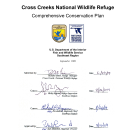What We Do
During the spring and summer, water is removed from the shallows of several impoundments to allow for the germination of natural wetland plants. After the plants have matured and produced an abundance of seeds, the impoundments are flooded. Waterfowl and other marsh birds feast upon these natural seed sources. Drawing the water down in the moist soil areas also produce mud-flats that nourish shorebirds during their spring and fall migrations.
Select refuge lands are offered to local farmers under the cooperative farming program. In exchange for a share of the crop, local farmers cultivate and plant the refuge’s fertile lands to produce corn, milo, and winter wheat for waterfowl. The refuge’s share is left unharvested in the field. Flooded agricultural fields of unharvested crops draw ducks and geese onto the refuge where they are able to feed and rest. Healthy, well-nourished ducks and geese depart the refuge in early spring.
Invasive plant species clog pipes, inhibit water flow, and out-compete native plants that provide beneficial food and cover. Thus, invasive species invasive species
An invasive species is any plant or animal that has spread or been introduced into a new area where they are, or could, cause harm to the environment, economy, or human, animal, or plant health. Their unwelcome presence can destroy ecosystems and cost millions of dollars.
Learn more about invasive species present a significant obstacle to resource management. Invasive or undesirable species occurring at Cross Creeks NWR include alligatorweed, parrotfeather, spatterdock, kudzu, privet, castor bean, Apple of Peru and Japanese stilt grass. Through impeding water management, invasive species contribute to the less than maximum productivity of the agricultural fields for waterfowl food that requires flooding. Spatterdock exists in the ponds, and alligatorweed out-competes native wetland species. Japanese stilt grass impacts natural regeneration, causes tree stress, and affects nesting habitat.
The refuge uses trapping as a wildlife management tool for the conservation and management of wildlife populations. Trapping may be used to protect endangered species, migratory birds, prevent and address property damage, control invasive species, and/or manage abundant species. All trapping activities are carefully managed to ensure that safe, effective practices are used and wildlife populations are sustainable.
Management and Conservation
Law Enforcement
Law Enforcement is critical to every aspect of wildlife conservation. The mission of the Law Enforcement program is to support the administration of the National Wildlife Refuge System through management and protection of natural, historical, and cultural resources, property, and people on lands and waters of our National Wildlife Refuges.

